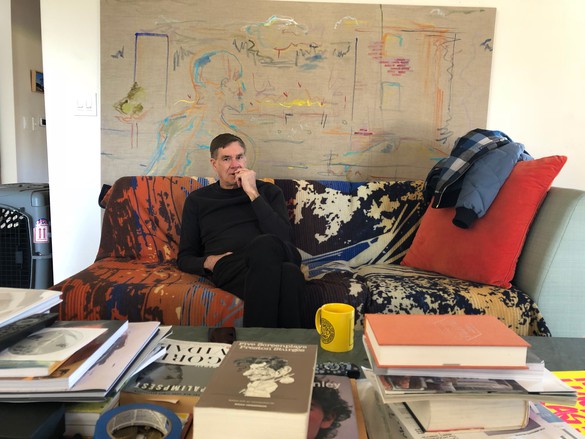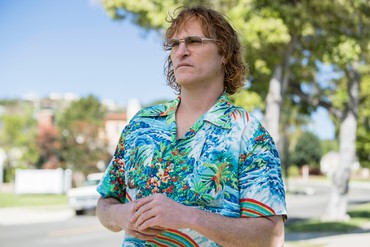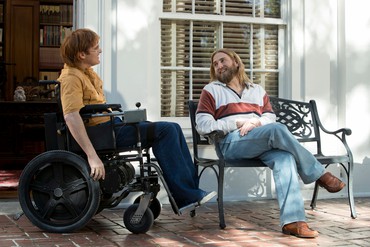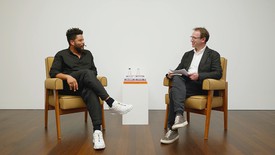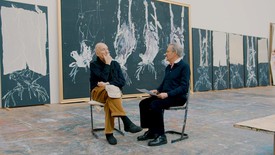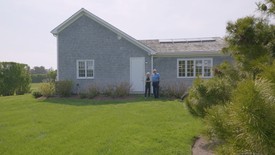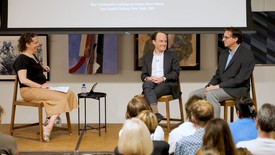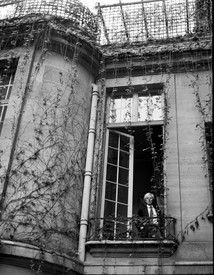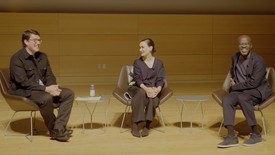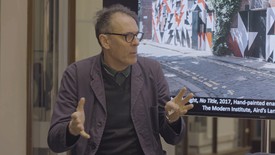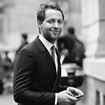
Derek Blasberg is a writer, fashion editor, and New York Times best-selling author. He has been with Gagosian since 2014, and is currently the executive editor of Gagosian Quarterly.
Derek BlasbergLet’s start at the beginning. Where are you from and what was it like?
Gus Van SantI was born in Mayfield, Kentucky, and I guess it was sort of like To Kill a Mockingbird. It’s a very enclosed community, but anything that exists, say, in New York City exists on some small scale in Mayfield. I never saw anything that would resemble modern art, but there was a painter named Helen LaFrance, who was black and in her eighties, and she cranked out tons of oil paintings. My father was involved in trying to get her work seen outside of town.
DBWas your family artistic?
GVSNot really. But we moved around quite a bit, I’d say almost every year.
DBWhy did you move around so often?
GVSMy father was a men’s clothing salesman. [The company] was called McGregor-Doniger and in the 1950s it was sort of like what Polo is today. You know the shirts that Desi Arnaz would wear on I Love Lucy? Those were McGregor-Doniger. They made some pretty cool stuff. Funny story: Ralph Lauren applied for a job there and he didn’t get it. I photographed him once and he recognized my name because it’s the same as my father’s. He said he’d met him and tried to get a designing job in the 1960s but it didn’t work out.
DBInteresting. So if your dad had hired Ralph Lauren then maybe there’d be no Polo today?
GVSI hadn’t thought about it like that but yeah, I guess.
DBI like the idea that we’re defined by our failures. It probably gutted him when McGregor didn’t hire him, but then he started Polo and now he’s worth a billion dollars.
GVSAlso, it feels good to hear about failure when people have been so successful.
DBGoing back to you moving around so often as a young person: do you think being transient and having to make new friends and go to new schools all the time helped adapt you into doing what you do now?
GVSOne thing I noticed was that wherever I went there was always a certain set of people who slotted into similar personalities. Once we moved from Atherton, California, to Darien, Connecticut, and even though those places were super different geographically, there were people who resembled each other personality-wise. [Moving so much] probably made me good at orienting myself, too. With film work you’re often doing that, because you have a brand-new crew every time. Maybe you’re able to get some of the same people, but a lot of times they’re new people and you have to learn quickly how to get what you need out of them.
DBI saw a Rhode Island School of Design mug in your kitchen.
GVSI was living in Oregon for high school and was looking for a good art college. I got into RISD early and I was going to send a box of art to CalArts but my parents were like, “No, you can’t. This is too good, you’re going to RISD. Just say yes and don’t make them wait.” I took their advice. I’m happy about that, although I have a lot of CalArts friends now. Really, Providence was so odd that now I think CalArts wouldn’t have been as cool. Providence is really one of the most unique places in the United States. Some of the people who seemed to be rebels at that time aren’t like that at all now. Now those are the guys who go to the reunions. I guess as you get older you get mellower.
DBHow did you get into filmmaking?
GVSOne of the RISD teachers brought ten students to Rome in 1975 to visit filmmakers. My film teacher was Marian Marzynski and we were being guided by Gideon Bachmann, who was this US journalist stationed in Rome and knew all the directors. So we were visiting Fellini’s sets while he was shooting Casanova, and we visited Pasolini.
DBThat’s awesome!
GVSYeah, it was super awesome. That was just before the Italian cinema started to disappear. We didn’t really know how awesome it was. Honestly, I don’t think I’d ever seen a Pasolini film. In college I abandoned painting because it was the mid-’70s and a lot of students did. The Talking Heads were painting students and they decided to be rock stars. There were a lot of people changing majors and changing objectives. You kind of fled painting because it felt like there was an overabundance of painters then. Looking back, maybe if you’d stuck it out, things would have gotten rosier. But percentage-wise, fewer painters succeeded than almost anything. Sometimes former graduates would come back from New York and tell classes, “There’s only forty galleries and I’ve dropped these off at forty galleries and nobody looks at any of them.” So we were thinking, “Maybe I should be majoring in something different than painting.” Back then, I thought majors meant something and now I think they kind of don’t.
DBThat’s a very discouraging alumni visit.
GVSYeah, for the painting department. For me it was easier to be in film. Painting was already getting a little boring because I’d painted long enough, it was something I felt like I did already. I’d done it through high school pretty seriously. Filmmaking was so complicated and it was fun to learn something that was so difficult.
DBYou didn’t abandon painting entirely, which I know because you exhibited at Gagosian in 2011. You’ve also shown your photographs in museums. Tell me: how do you switch gears between these media? Are there similarities?
GVSFor me, they’re all just different disciplines that were picked up along the way. The first thing that I was doing was drawing and painting and printmaking in art class, and then I started filmmaking when I was sixteen because I had realized that some painters were making films in New York City. Like Jonas Mekas. I bought a camera and was playing around with film. I started playing music when I was thirty because you could buy a multitrack recorder, which was brand new in 1980, for $1,000 and it did a good job at recording four different channels of sound. That was huge. Before that it was like, “How do you mix the sound without going to an official sound mixing stage?” And this was the answer. I made six albums with that thing, but those were more of a hobby.
I’ve been making things up from my imagination, recently at least, as opposed to from life. It looks like it’s from life, but it’s just from my own mind.
Gus Van Sant
DBOftentimes someone will say, “When I’m stressed I prefer to paint, or make music.” I’m jealous of those people.
GVSDid you know Winston Churchill painted?
DBYes, but only because, randomly, where I grew up in St. Louis, Missouri, there was the largest retrospective of Winston Churchill’s watercolors ever.
GVSWas he any good?
DBHe was pretty good, but he did it more as therapy.
GVSFascinating. He painted a lot, probably while he was working, while he was dictating. There’s a book I just read about a millionairess who was friends with the Churchill family. He’d come down and hang out through all those periods, before the war, during the war, and up until she died.
DBHistory doesn’t think of him as a creative, does it? In your case, though, filmmaking is not stress relief, it’s about telling a story.
GVSAll of it is a kind of stress relief. If I’m not doing anything, I get stressed. So I do things just to not be stressed.
DBHow are you inspired to find your stories?
GVSHonestly, it’s just me sitting around and finally I’ll go, “Oh! It’d be cool to do this.” And then I just do whatever it is.
DBAre you gonna make a painting of the millionaire expat who hosted Churchill?
GVSYou know, I’ll say no now, and then it’ll be the next thing I’m thinking about, and then I’ll do it. I’ve been making things up from my imagination, recently at least, as opposed to from life. It looks like it’s from life but it’s just from my own mind.
DBI was surprised to learn you lived here in LA now because I assumed you were still in Oregon.
GVSI moved to Oregon in 1983. Well, I moved back there, because I went to high school there from 1970 to ’72. After RISD, I went and lived in New York and worked in advertising, but I had a project in mind that I wanted to do in Portland. I saved up my advertising money so that I could afford to make the movie and made Mala Noche [1986], which was my first feature.
DBWas it crucial to be in Portland?
GVSIt was set there. I guess it could have been adapted to another city. It was skid row in Portland, so you could have done it on the Bowery, I guess. But you’d have to have changed some other things too, and I didn’t want to do that.
DBWere you averse to leaving Portland?
GVSA little bit. I left in 2000 when I moved to New York because I was shooting there. Finding Forrester was the film. I was renting a place on Canal Street, and while I was renting that place the upstairs penthouse came up for sale and it was affordable so I bought it. After about a year and a half, the World Trade Center was hit by planes, which was scarily nearby. Looking back, I wasn’t doing the New York thing correctly. I didn’t have the knack for it because I didn’t realize you need to get out sometimes to stay sane. You have to balance things out by going somewhere on the weekends. I wouldn’t go anywhere on the weekends. After about a year I was like, “I’ve had about enough of this.” I wasn’t making use of the city properly, I was living as if I were in the suburbs—meaning I didn’t go out, I didn’t see shows or go to parties. I did things about as many times as you would if you lived in Connecticut. Also, I thought that my place on Canal Street was going to go down in value because everyone was moving out after 9/11, which was wrong. It was a bad real estate move to leave.
DBWhen did you move here full time?
GVSI went back to Portland and I stayed for another decade or so. I bought this place and started coming down every now and then. And then last year I sold my place in Portland because I bought a place in Palm Springs and now I go there as much as I can.
DBIs it easier to work here than in New York?
GVSFor sure. It’s like a suburb here.
DBHa! I fantasize about the idea of having a real life with a house and dog and a car.
GVSI think I really like that. I found out that about myself. Although I still fantasize about New York, I should just go there for a month and that would be enough. I don’t need to live in the city all the time. Part of it is, my business isn’t really in the city. It’s not really anywhere. I used to just drive back and forth between Portland and LA. Sixteen hours. I liked driving so I just would do it once every two weeks and think on the way.
DBWould you say you’re rootless?
GVSI think my family always moved so I always move. I’m intrigued by the idea of moving anywhere. If you say there’s a great place in Greece I’ll remember it and I’ll look into it. I don’t know if I’d move there but I’d look into it.
DBTalk to me about the film you’re working on now.
GVSDon’t Worry, He Won’t Get Far on Foot is about a cartoonist who lived in Portland, Oregon. It’s coming out in July. The cartoonist is a guy named John Callahan, who’ll be played by Joaquin Phoenix. Callahan is dead now, but he was working in the ’80s, ’90s, and ’00s. The ’90s were his big decade. I knew him in Portland, and he did things for the Village Voice, Penthouse, and Playboy. He became a quadriplegic after a drunken accident when he was twenty-one, which is a part of the story we’re telling. Some of his cartoons were about people with disabilities and he would get in trouble because they were humorous at the expense of disabled people. The public wouldn’t know that he also was disabled, so he would receive a lot of hate mail.
DBAnd then he’d have to reveal his disability?
GVSI don’t think he even bothered. I think he liked the whole reaction that he got.
DBWhat appealed to you about this story?
GVSPart of his story is about his alcoholism, and our version of his life is sort of centered on that. So it’s like a self-help movie.
DBYour version of a self-help book. Got it. Have you worked with Joaquin in the past?
GVSOne time, in the movie To Die For [1995].
DBOf course! He was so young in that. He was so good in that. Tell me: what are you looking for when you’re casting someone?
GVSIn Joaquin’s case it’s somebody I knew and we had talked about working on something together again. We sort of found this and it seemed like a really good mix. Originally this was Robin Williams’s project. He had bought a biography written by John Callahan because he knew the cartoons. As a San Franciscan, he knew the weekly paper that printed Callahan. He had bought the book and then invited me to help with it. So it was an old project from the ’90s that I had been working on.
DBIs there a Gus Van Sant formula for casting? What appeals to you?
GVSI like people who can go off script. I sometimes cast doing that. In Elephant [2003] there was no script and the actors had to go entirely off script. That usually gets me very interested, because if they can be the character and make new things up, it starts to become more real than reading a script. It feels more genuine that way. Although one time I found an actor who couldn’t do the script but was great at making stuff up. I was tempted to go with him, but I thought, “Well, we do have to actually tell a story, so maybe it’s not a good idea.” That’s usually what I’m looking for: people who are naturally able to be the character.
DBIn To Die For, Joaquin’s character is obviously on the fringe of society. And a quadriplegic cartoonist, one would probably agree, is also probably not the center of society. Would you say you’re always on the fringe?
GVSYeah, John was definitely on the fringe, he was an alcoholic quadriplegic and for seven years he didn’t work as a cartoonist, he was always hanging out in parks drinking wine. He realized, after seven years of that, that his difficulty wasn’t the wheelchair, it was his drinking, and he had kind of an epiphany and stopped.
DBThat’s a real epiphany.
GVSHe just stopped, although his life was already completely unmanageable. As a quadriplegic, he had some assistance from an insurance company from the accident and from the government, but the therapy involved in being quadriplegic is so intensive that it’s almost like a Sisyphean effort. You’re basically a head without a body. And he was drinking all day! On top of being a mess, he was a mess.
DBFor your creative process, are you trying to tell a story or are you trying to express yourself? Or are you just trying to create works of art?
GVSI try to make it narrative, but it’s coming from a social environment, or even just the social reactions in an environment. For example, I’ll go to a flea market and think, “This would be a great movie.” Then I’ll start to see the entire movie happening in front of me because all these different interactions are happening. I can be almost anywhere and begin thinking, “This is a really good place for a setting.” Then if I go farther I start actually making up characters that are in that world. That’s where it starts, the environment, usually. Not necessarily a singular person.
DBDo you think you’ll always attend to people on the fringes of society?
GVSProbably. I think all subsets of society. You could do a movie about the fringes of the financial business if you wanted. They might be considered a higher fringe, but every group is still outside of something. Even the White House: very fringe right now.
DBYou could do a trilogy of movies about the Trump administration. Did you see that Hope Hicks just quit?
GVSLet’s think about that story. Why do you suppose she left?
Film stills: courtesy Amazon Studios
